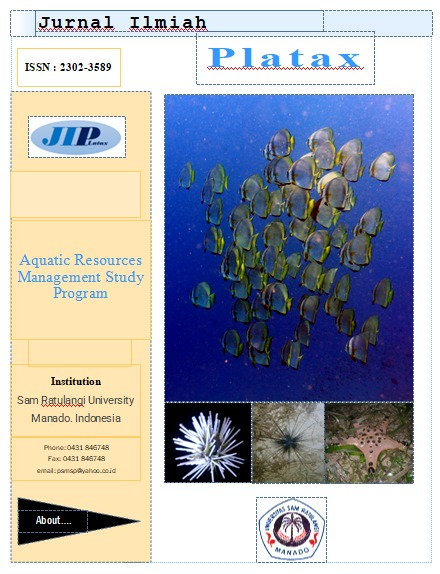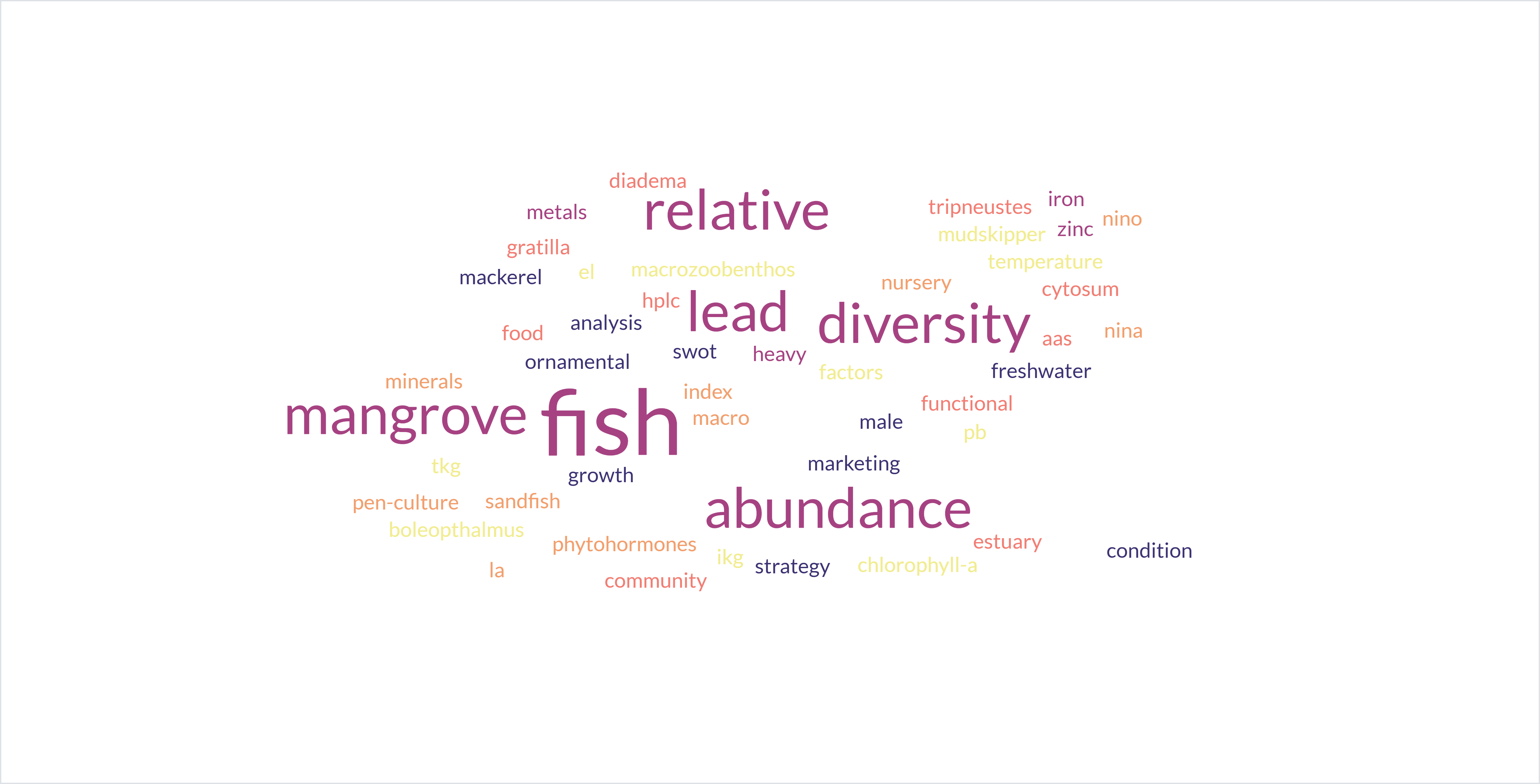Antibacterial potential of marine fungus Aspergillus nomius isolated from green algae Bornetella sp
DOI:
https://doi.org/10.35800/jip.9.1.2021.33781Keywords:
isolation, marine fungi, Aspergillus nomius, green alga, Bornetella spAbstract
Isolation of marine fungi symbiont of green algae Bornetella sp as a producer of antibacterial compounds has been carried out. This study aims to obtain symbiont fungi from green algae Bornetella sp which produces antibacterial compounds. The symbiont fungus was isolated using the direct planting method. Screening for the antibacterial activity of pure symbiont fungi isolates against Escheriscia coli and Staphylococcus aureus, and was carried out by the agar diffusion method. The isolation results obtained 4 isolates, but the one with the most potential to inhibit the growth of the tested bacteria was MFALM2. Molecular characterization showed that the MFALM2 isolate was identified as Aspergillus nomius with a 100% closeness level.
Keywords: isolation; marine fungi; Aspergillus nomius; green alga; Bornetella sp.
Â
Abstrak
Isolasi jamur laut yang bersimbion dengan alga hijau Bornetella sp sebagai penghasil senyawa antibakteri telah dilakukan. Penelitian ini bertujuan untuk memperoleh jamur simbion dari alga hijau Bornetella sp yang menghasilkan senyawa antibakteri. Isolasi jamur simbion dilakukan dengan metode direct planting. Skrining aktivitas antibakteri isolat murni jamur simbion terhadap bakteri uji Escheriscia coli dan Staphylococcus aureus dilakukan dengan metode difusi agar. Hasil isolasi diperoleh 4 isolat, namun yang paling berpotensi menghambat pertumbuhan bakteri uji adalah MFALM2. Karakterisasi molekuler menunjukkan bahwa isolat MFALM2 teridentifikasi sebagai Aspergillus nomius dengan tingkat keeratan sebesar 100%.
Kata kunci: isolasi; jamur lau; Aspergillus nomius; alga hijau; Bornetella sp.
References
Artasasta, MA., Yanwirasti, Taher M., Djamaan A., Handayani D. 2019. Cytotoxic and antibacterial activities of marine sponge-derived fungus Aspergillus nomius Nc06. Rasayan J. Chem., 12(3): 1463-1469.
Caroll AR., Copp BR., Davis RA., Keyzers RA., Prinsep MR. 2020. Marine natural products. Nat. Prod. Rep. https://doi.org/10.1039/C9NP00069K
Deshmukh SK., Prakash V., Ranjan N. 2018. Marine fungi: a source of potential anticancer compounds. Front. Microb., 8: 2536. 10.3389/fmicb.2017.02536.
Hong-Lei Li, Xiao-Ming Li, Xin Li, Sui-Qun Yang, Bin-Gui Wang. 2019. Structure, absolute con guration and biological evaluation of polyoxygenated meroterpenoids from the marine algal-derived Aspergillus terreus EN-539. Phytochemistry Lett., 32: 138-142.
Hudzicki, J. 2009. Kirby-Bauer disk diffusion susceptibility test protocol. American Society for Microbiology. 23 hal.
Kjer J., Debbab A., Aly AH., Proksch P. 2010. Methods for isolation of marine-derived endophytic fungi and their bioactive secondary products. Nat. Protoc., 5: 479-490. 10.1038/nprot.2009.233
Manikandan P., Varga J., Kocsube S., Samson RA., Anita R., Revathi R., Doczi I., Nemeth TM., Narendran V., Vagvolgyi C., Manoharan C., Kredics L. 2009. Mycotic keratitis due to Aspergillus nomius. J. Clin. Microbiol., 47:3382-3385.
Meenupriya J., Thangaraj M. 2012. Bioprospecting of potent fungal strains from marine sponge Hyatella cribriformis from Gulf of Mannar Coast. International Conference on Bioscience, Biotechnology and Healthcare Sciences (ICBBHS'2012) December 14-15, 2012 Singapore.
Mongi AWWS., Sumilat DA., Losung F., Mangindaan REP., Lintang RAJ., Undap SL. 2020. Bioaktivitas jamur Aspergillus flavus yang bersimbion dengan ascidian Eudistoma sp. Jurnal Pesisir dan Laut Tropis 8 (2): 21-26.
Ortez, J.H. 2005. Disk diffusion testing in manual of antimicrobial susceptibility testing. Marie B. Coyle (Coord. Ed). American society for Microbiology.
Raghukumar S. 2017. Fungi in coastal and oceanic marine ecosystems. Springer International Publishing AG. 378 pp.
Shukla S., Kim D-H., Chung SH., Kim M. 2016. Occurrence of aflatoxins in fermented food products (chapter 28) In: Fermented foods in health and disease prevention. Edited by Frias J, Martinez-Villaluenga C and Peñas E. Academic Press: 653-674
Sumilat DA., Ginting EL., Pollo, GAV., Adam AA, Tallei TE. 2020. Antimicrobial Activities of Rhopalaea-Associated Fungus Aspergillus flavus Strain MFABU9. Pakistan Journal of Biological Science. 23 (7): 911-916. doi:10.3923/pjbs.2020.911.916
Tam EWT., Chen JHK., Lau ECL., Ngan AHY., Fung KSC., Kim CL., Ching WL., Kwok, YY, Lau SKP., Woo PCY. 2014. Misidentification of Aspergillus nomius and Aspergillus tamarii as Aspergillus flavus: Characterization by Internal Transcribed Spacer, ß-Tubulin, and Calmodulin Gene Sequencing, Metabolic Fingerprinting, and Matrix-Assisted Laser Desorption Ionization-Time of Flight Mass Spectrometry. Journal of Clinical Microbiology, 52(4): 1153–1160.
Yang SQ., Xiao-Ming Li, Xin Li, Hong-Lei Li, Ling-Hong Meng, Bin-Gui Wang. 2018. New citrinin analogues produced by co-culture of the marine algal-derived endophytic fungal strains Aspergillus sydowii EN-534 and Penicillium citrinum EN-535. Phytochemistry Lett., 25: 191-195.
Zhang P, Xiao-Ming Li, Xin Li, Bin-Gui Wang. 2015. New indole-diterpenoids from the algal-associated fungus Aspergillus nidulans. Phytochemistry Lett., 12: 182-185.
Downloads
Published
How to Cite
Issue
Section
License
COPYRIGHT
Authors who publish with this journal agree to the following terms:
Authors hold their copyright and grant this journal the privilege of first publication, with the work simultaneously licensed under a Creative Commons Attribution License that permits others to impart the work with an acknowledgment of the work's origin and initial publication by this journal.
Authors can enter into separate or additional contractual arrangements for the non-exclusive distribution of the journal's published version of the work (for example, post it to an institutional repository or publish it in a book), with an acknowledgment of its underlying publication in this journal.
Authors are permitted and encouraged to post their work online (for example, in institutional repositories or on their website) as it can lead to productive exchanges, as well as earlier and greater citation of the published work (See The Effect of Open Access).






































